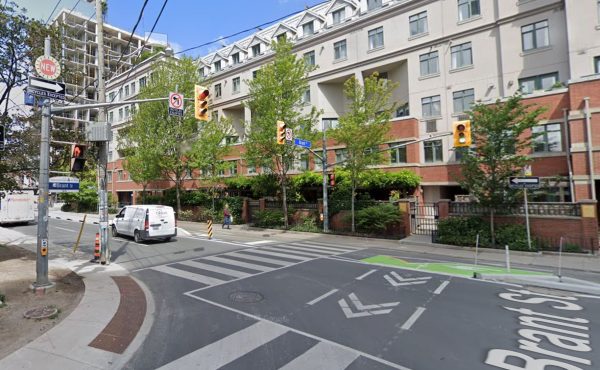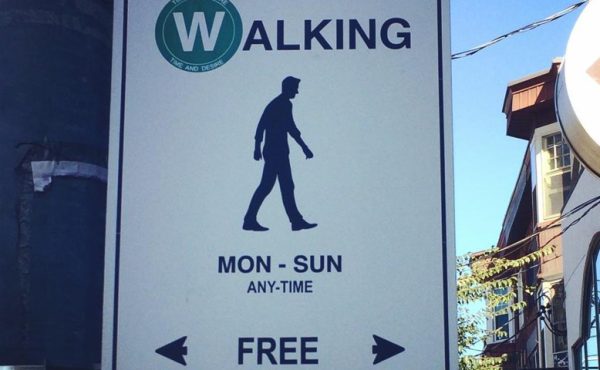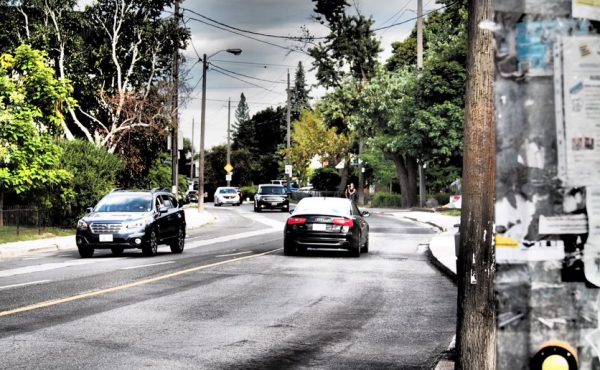

I’m not sure if anyone else has noticed but Toronto’s waterfront doesn’t seem to be on the radar of the mayoral candidates in this election. This is surprising since one of the candidates (Joe Pantalone) is a city councillor of a ward that borders Lake Ontario while another one (George Smitherman) used to represent a provincial riding that includes the Toronto Island, airport, Don River, and skirts the Port Lands. I suspect it’s only a matter of time before HTO Park’s yellow umbrellas are introduced to the miser wrath of Rob Ford.
But this post is not meant to challenge candidates. Instead, I’d like to discuss our access to the waterfront. Or more importantly, how the City of Toronto and Waterfront Toronto have dropped the ball on effectively directing pedestrians and cyclists to make their way down to Lake Ontario.
I live in the most southern part of Parkdale, just west of the CNE grounds. The Jameson pedestrian bridge that crosses over the eastbound lanes of Lakeshore Blvd. is a one-minute walk from my place and I have a clear view of it from my balcony. It’s used quite often by walkers and cyclists. But it’s the only entry point to the waterfront and the Martin Goodman Trail for over a kilometre in either direction.
So how is this vital access point promoted? With two rather insignificant signs: one is a few blocks away from the bridge itself (see it on Google StreetsView at Jameson and King West) and another sign is two short blocks away at Dunn and Springhurst, both residential streets (shown above). These are the only signs I’ve found in the western part of the city promoting access to the waterfront. The other popular pedestrian bridge, at Roncesvalles and King, has a grand total of zero signs promoting its location.
Not only is the current sign poorly designed, its placement is odd: they are installed at a height designed specially for drivers, yet the signs are intended for pedestrians and cyclists. Better placement of the sign — possibly eye-level and installed in the boulevard part of sidewalks — would be more appropriate, as would placing them much further north into the city.
And it’s not as if the City doesn’t know the value of good signage: the recently installed signs for ravines, creeks and rivers (shown below) are great examples of how to promote the city’s greatest natural asset.

What’s more frustrating (for me, at least) is that there are less traffic obstacles for pedestrians and cyclists in this part of the city than currently found in the central waterfront area (see Dylan Reid’s post from August 2008 about walking to the waterfront south along Spadina). Overtly promoting the safe access to the waterfront in this part of the city should be a no-brainer.
In Spacing’s second issue, back in the summer of 2004, we talked to Ken Greenberg, one of Toronto’s most highly-regarded urban designers, about the one specific thing he’d do to promote walking in the city. His idea was the create “Walks To The Water”. Simply put, if the City improved the experience of walking down to the lake along the north-south streets more people will go the waterfront.He wrote:
“One of the great pedestrian divides in Toronto is the inhospitable passage from the established part of the city north of Front Street and east of Yonge Street, the Esplanade and Mill Street to the central waterfront. While it is physically possible to cross these relatively short distances on foot on Cherry Street, Parliament, Sherbourne, Jarvis, Yonge, Bay, York, Spadina, Bathurst and even on Strachan, not one of these walks is inviting. In fact they are downright discouraging and bleak. Eventually they may be improved by redevelopment along the routes, but at the current rate this could take forever. Why not show a positive sign now and make modest investments in making these into great ‘Walks to the Water’ with improved paving, lighting, street furniture, planting, signage, and public art?”
If Toronto is ever to get serious about attracting people down to the lake from other parts of the city, one of the easiest things they could do is to start installing a series of well-designed signs that promote waterfront access points. And hopefully, there will be more than two signs.
Top photo by Matthew Blackett; bottom photo by Esmond Le




11 comments
Good article Matt,
Worth noting is that Sherbourne will be substantially facelifted from Front to to the Waterfront next year.
Jameson in parkdale is being faceliffed, as I’m sure you know, and the re-do of the bridges over the Gardiner that’s happening now (concluding summer 2011) includes some improvements to pedestrian access to the water and some landscaping improvements.
Yonge St got bike lanes and improved streetscapes last year as well. So progress is being made as of late. Though more, faster would be wonderful.
The signage for the creeks/rivers is all right at the crossing of those water bodies, but doesn’t really direct ‘access’ as such.
I think as the Waterfront Trail is more fully realized, fully signing that route as the Waterfront Trail (which has recognizable signage) would be a sensible start, then perhaps using ‘To Waterfront Trail’ signange nearby. A couple of the better known beaches might benefit from their own sigange (ie. Sunnyside) as well.
It’s likely that even fewer signs will appear if Rob Ford is the next Mayor of Toronto.
Mr. Ford attacked proposals for signs identifying water features of the city — such as the “Lower Don River” signs that you posted in your article — because, “people who live here already know it’s the Don River.”
walking down to the water anywhere from Jarvis to Bathurst is the pits. I hate crossing Lakeshore. Obviously Spadina is particularly bad. This needs attention.
Thanks for starting the discussion. A couple weeks ago I biked down the new Jarvis lane to go to Sugar Beach (which is fantastic!). It was nearly impossible once the lanes ended, especially going past St. Lawrence Market.
On a more positive note, the bike lanes on Simcoe between Front and the lake are great and pretty fun with the hill created for the underpass.
I especially like the signage for creeks and rivers. However, I would like to see the same signage for buried creeks such as Taddle Creek and Jane Creek. Unless Rob Ford gets in and we won’t be getting any information signs of any kind.
Biking down Jarvis has become such a pleasure now, until you hit Queen, and it’s terrifying again. Two steps forward, one back, I guess. Some sharrows or something would be nice.
Fort York Boulevard is another place where the City did 80%, then left 20% undone.
As an alternative connection to the Waterfront Trail to taking Bathurst, Fort York Blvd. is great until you hit Lake Shore Blvd. The bike lane just ends. Huh? The trick is to get into the left-turn lane, make a wide left turn, and get onto the poorly-paved sidewalk/trail that starts just east of the intersection, and head west to an awkward junction with the southern continuation of Strachan Ave.
For pedestrians, this is a pretty miserable crossing too. But the other choices are either Strachan with its umpty-way traffic signals, or Bathurst and its umpty-way signals plus added streetcar tracks.
Even in south Etobicoke, the Waterfront trail is mis-signed in a few places, and there are few signs on Lake Shore Boulevard pointing to some smaller lake-side parks which have great views of downtown across Humber Bay.
Greater access to the waterfront is a great point. In fact I thi that is one of the main points with the planning taking place. As I understand it the east end is the responsibility of Waterfront Toronto whereas the western waterfront is a project undertaken by the city. If I am wrong could someone let me know.
Cheers
Iain
Good article! I live in Parkdale as well; usually I take the pedestrian bridge at Roncesvalles to go walk along the lake, but today I decided to try the Jameson one, which people had told me about but I’d never actually been across. It’s a tad scary what with all the traffic on Lakeshore, and you’re right—if no one had told me there’s a bridge at Jameson I would never have found it myself.
Maybe metal plaques in the sidewalk (like the one at the southwest corner of Trinity-Bellwoods) would help people navigate? Or banners on streetlights, like there are along Queen West? But hey, if Rob Ford gets in he’ll probably rip out the sidewalks, then drain the lake for good measure. 😛
I tried going down to the Western Beaches recently and had a terrible time. The bridge across the lakeshore was loud and uninviting, there was no shade along the boardwalk towards Sunnyside, Sunnyside pool was closed for construction, the beach was contaminated, Sunnyside pavilion sold overpriced food and beer, and the playground for my kids even sucked.
Sorry to be so negative. I’m usually a very positive person in regards to Toronto. I would love better access to the waterfront and a better waterfront, but sorry we’ve got a long way to go.
Dufferin Grove in comparison seems like heaven.
It is certainly difficult to see how to get to the waterfront but the pedestrian signage in Toronto is not good anywhere. I live near St Lawrence Market and am constantly telling people who look confused how to get to (or from) the Distillery. These two ‘attractions’ seem to attract the same kind of people and it’s ridiculous there are NO signs and the most obvious way there to the few who can read maps is along Front Street when a walk on The Esplanade is a MUCH more scenic route! I suggested this to our local BIA and was told they had asked the City to put some signs up but it was likely going to take several years! (There IS a To the Waterfront” sign outside St Lawrence Market – it sends people down Lower Jarvis which is how to get there but not a very pleasant walk.